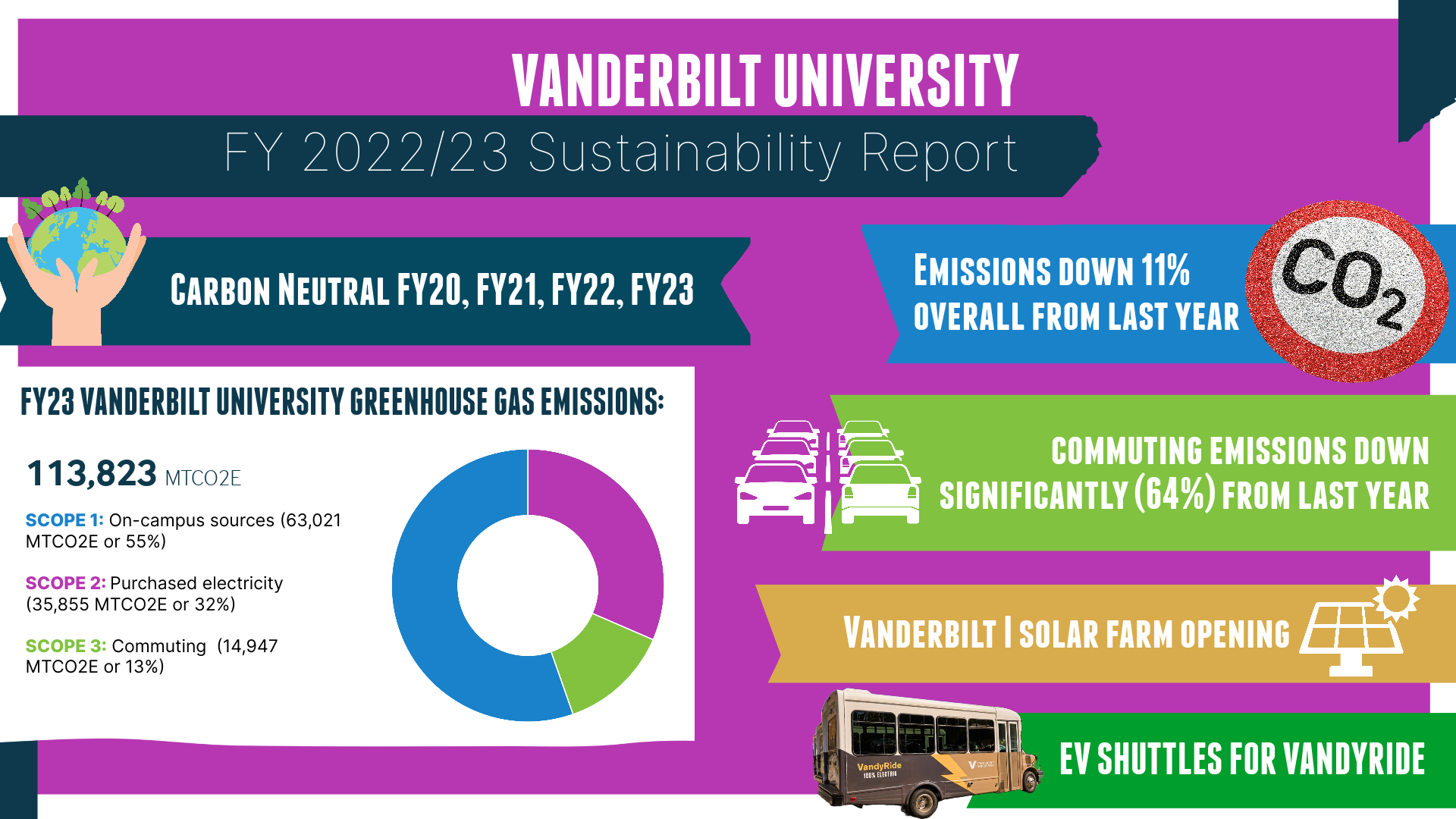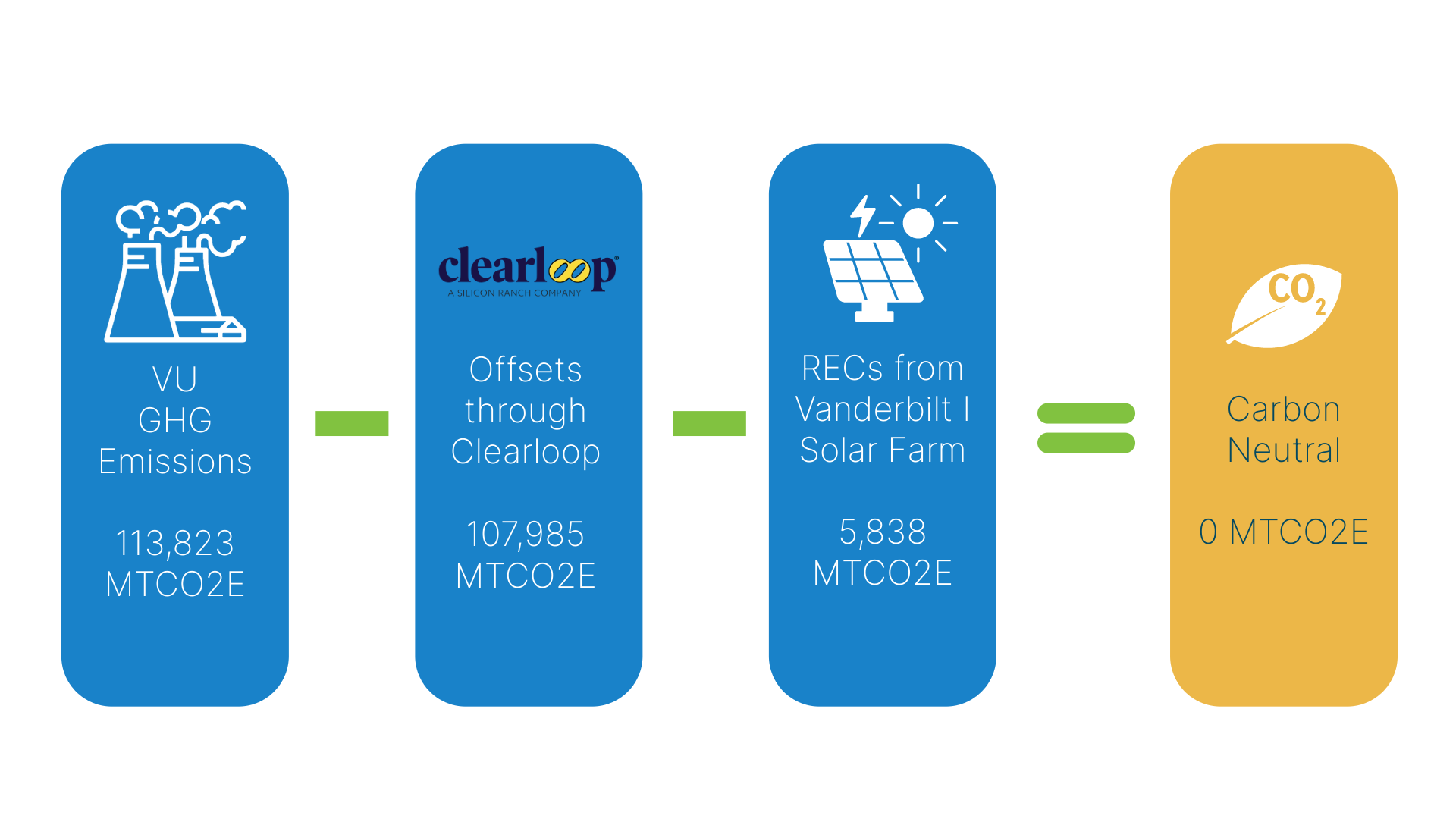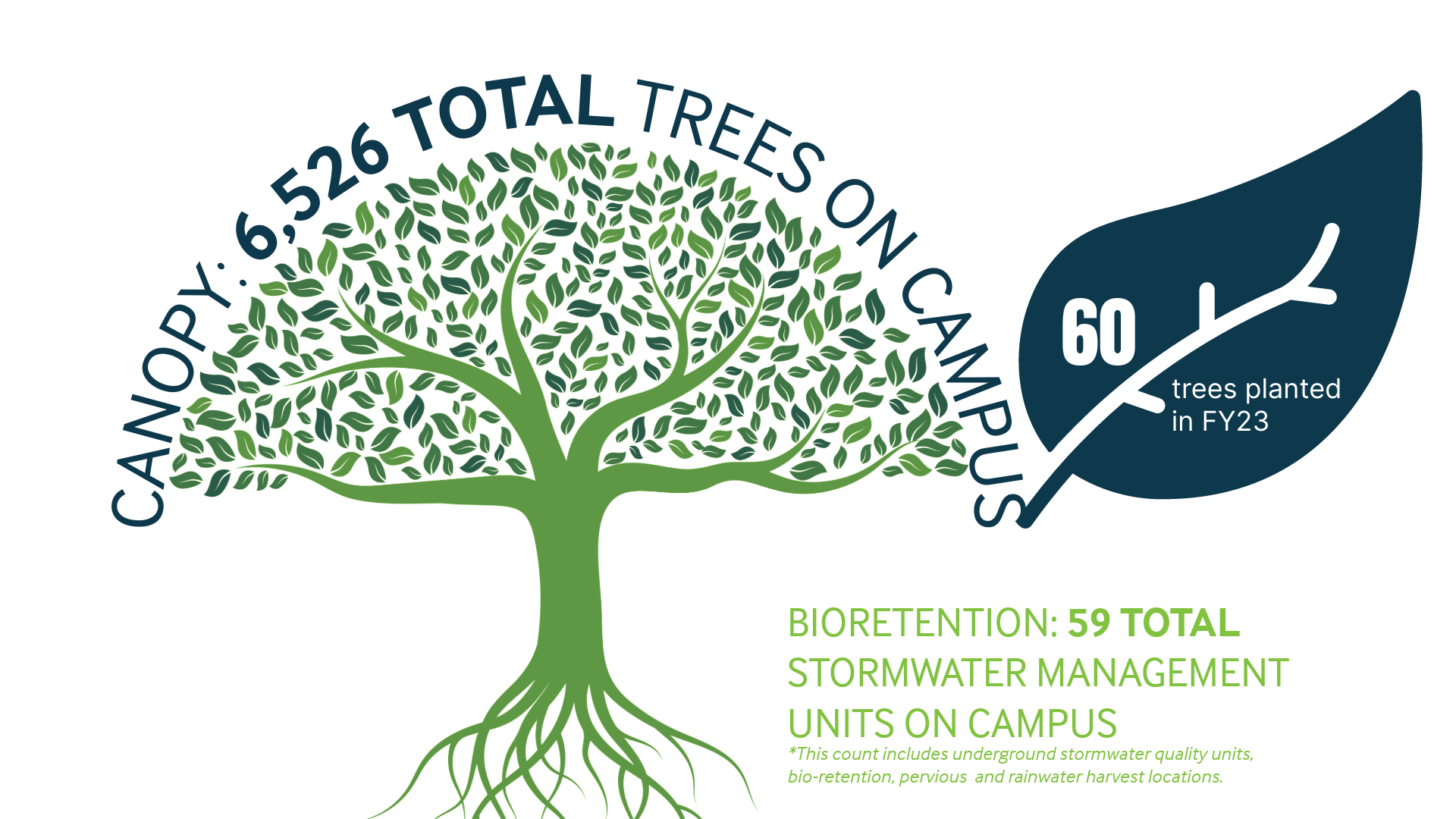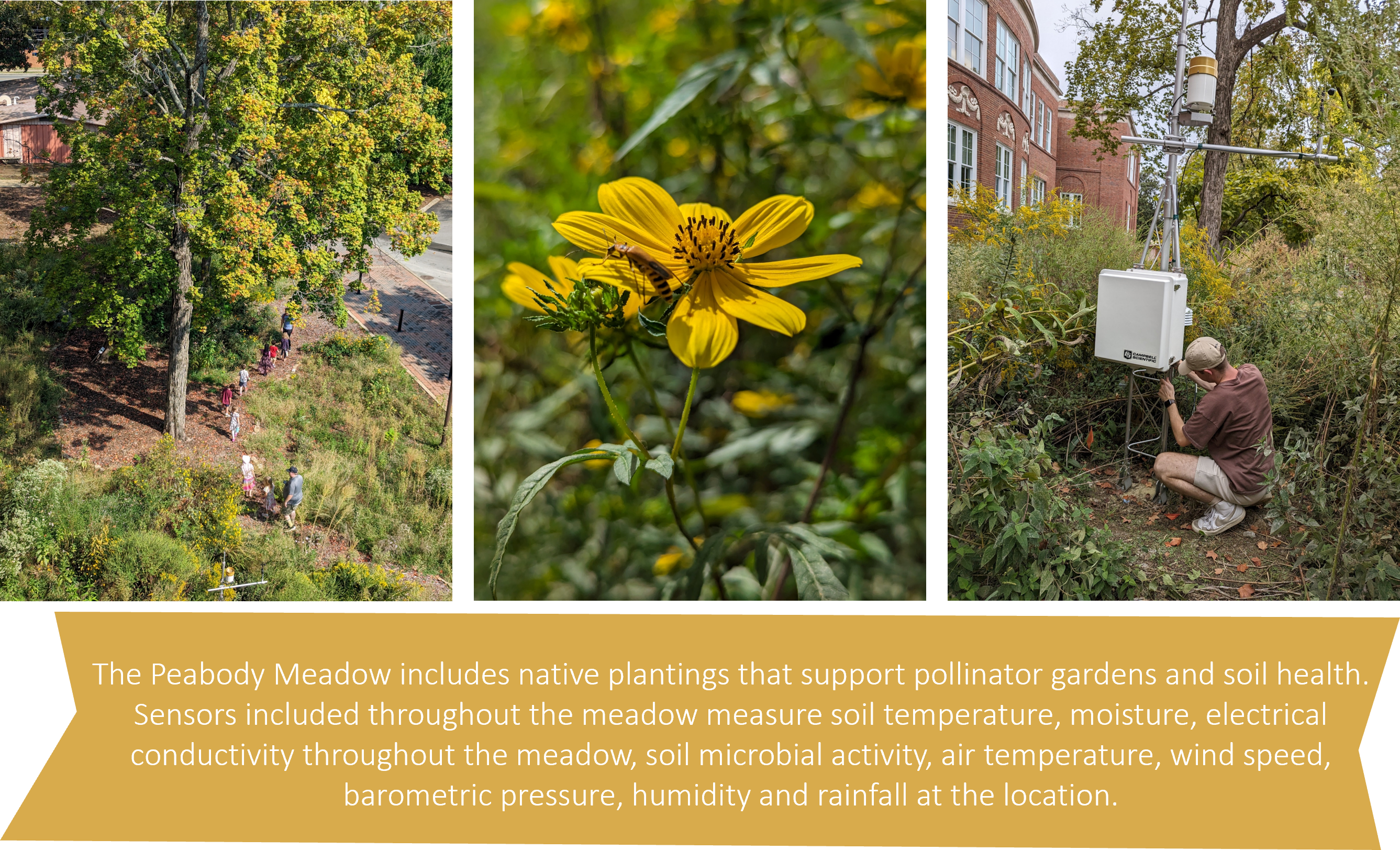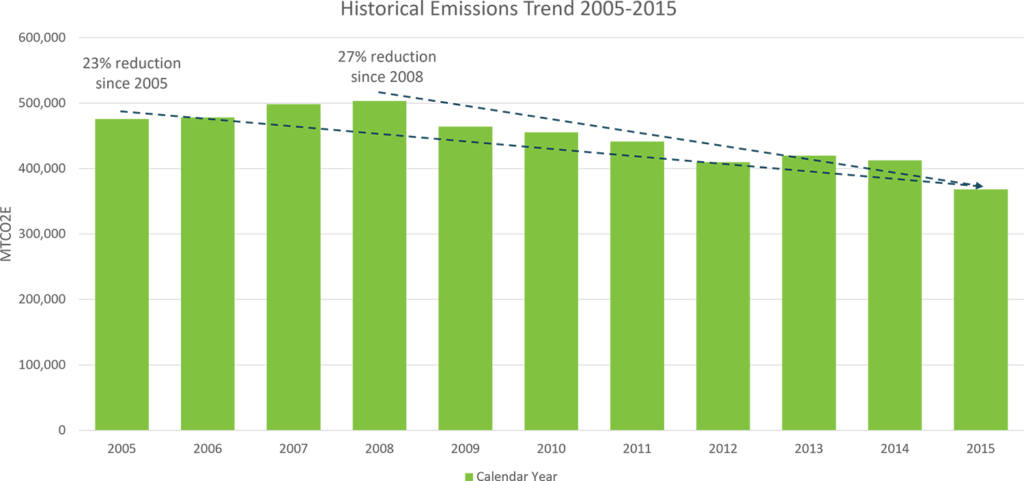Annual Sustainability Report FY2022-2023
Introduction
University Background

University Greenhouse Gas Emissions Background
Vanderbilt University operates an on-site co-generation power plant that meets steam, hot water and a portion of chilled water needs for heating and cooling of the university and Vanderbilt University Medical Center. Excess heat from the steam generating process is used to generate 25 percent of the electrical needs of the university. The remaining 75 percent of electrical needs of the university are purchased from the Tennessee Valley Authority through Nashville Electric Service. Vanderbilt emits greenhouse gases (GHGs) through power plant processes as well as university fleet vehicle use, refrigerant releases, faculty and staff commuting to work, air travel paid for by the university, and waste disposal and recycling.
Six GHGs emitted into the atmosphere comprise the majority of the carbon footprint. The amount of emissions of each gas is converted to a standard unit of measure of metric tons of carbon dioxide equivalents (MTCO2E) and then summed to determine Vanderbilt’s carbon footprint.
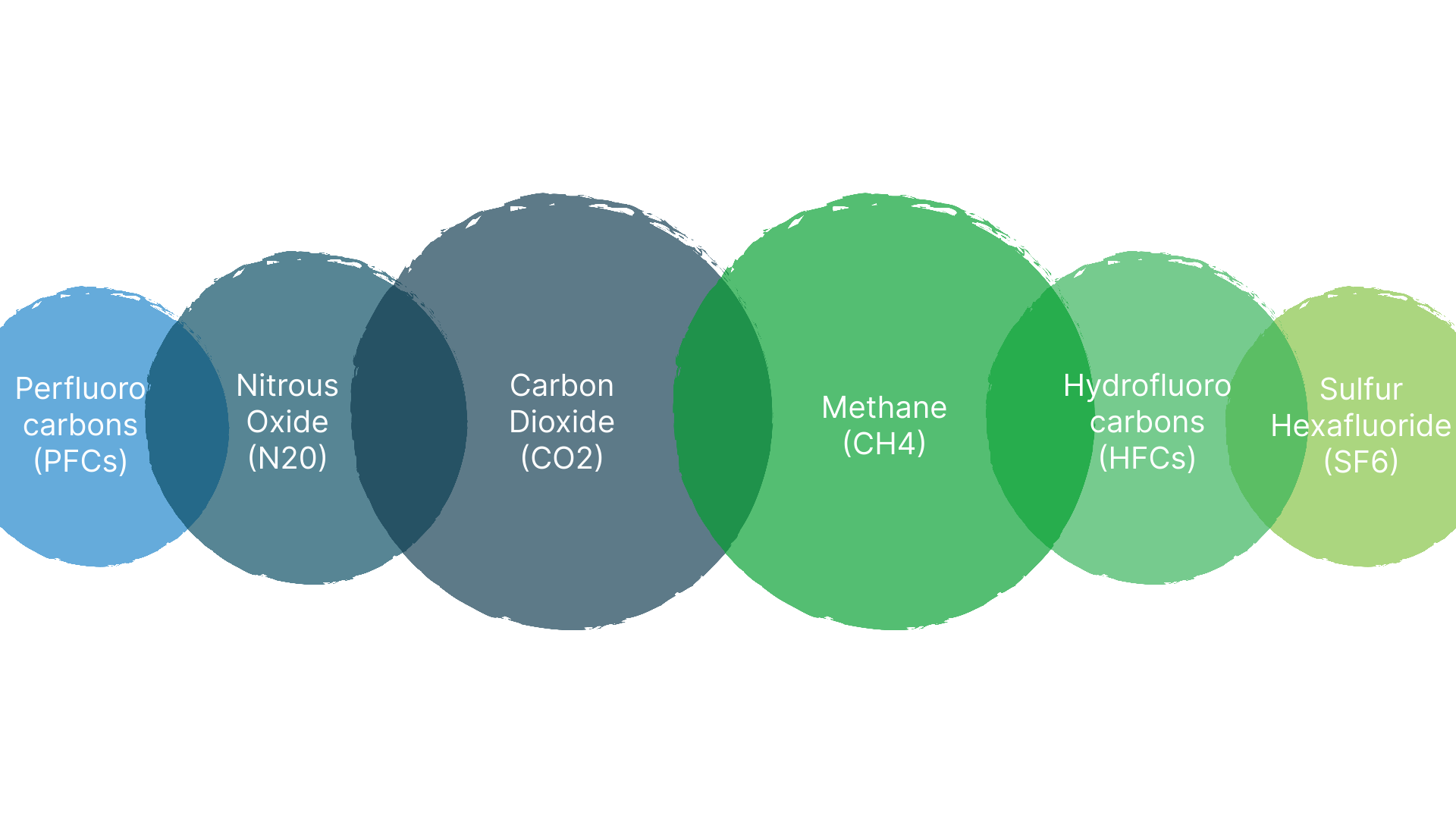
Vanderbilt University became an independent legal entity from Vanderbilt University Medical Center on May 1, 2016. Vanderbilt University is smaller in number of people and in square feet without the medical center, and therefore, the 2016 and forward greenhouse gas inventories are smaller in comparison with previous inventories (2005–2015). Because of the significant shift in GHG footprint due to the new organization, 2005–2015 GHG data is archived. The 2016 Annual Report contains first year baseline data for the university only, with the FY22–23 Annual Report presenting the seventh year of trending data. This sustainability report is intended to portray Vanderbilt’s current carbon footprint as accurately as possible and to highlight key sustainability gains from July 2022 to June 2023, aligning with the Vanderbilt academic and fiscal year cycle.
This report is developed by the Vanderbilt Environmental Health, Safety, and Sustainability office. Any questions should be directed to futurevusustainability@vanderbilt.edu.
Carbon Footprint
carbon neutrality
On Earth Day 2019, Vanderbilt University unveiled a comprehensive long-term strategy to significantly reduce its environmental footprint in part by powering its campus entirely through renewable energy, with the goal to be carbon neutral by 2050.
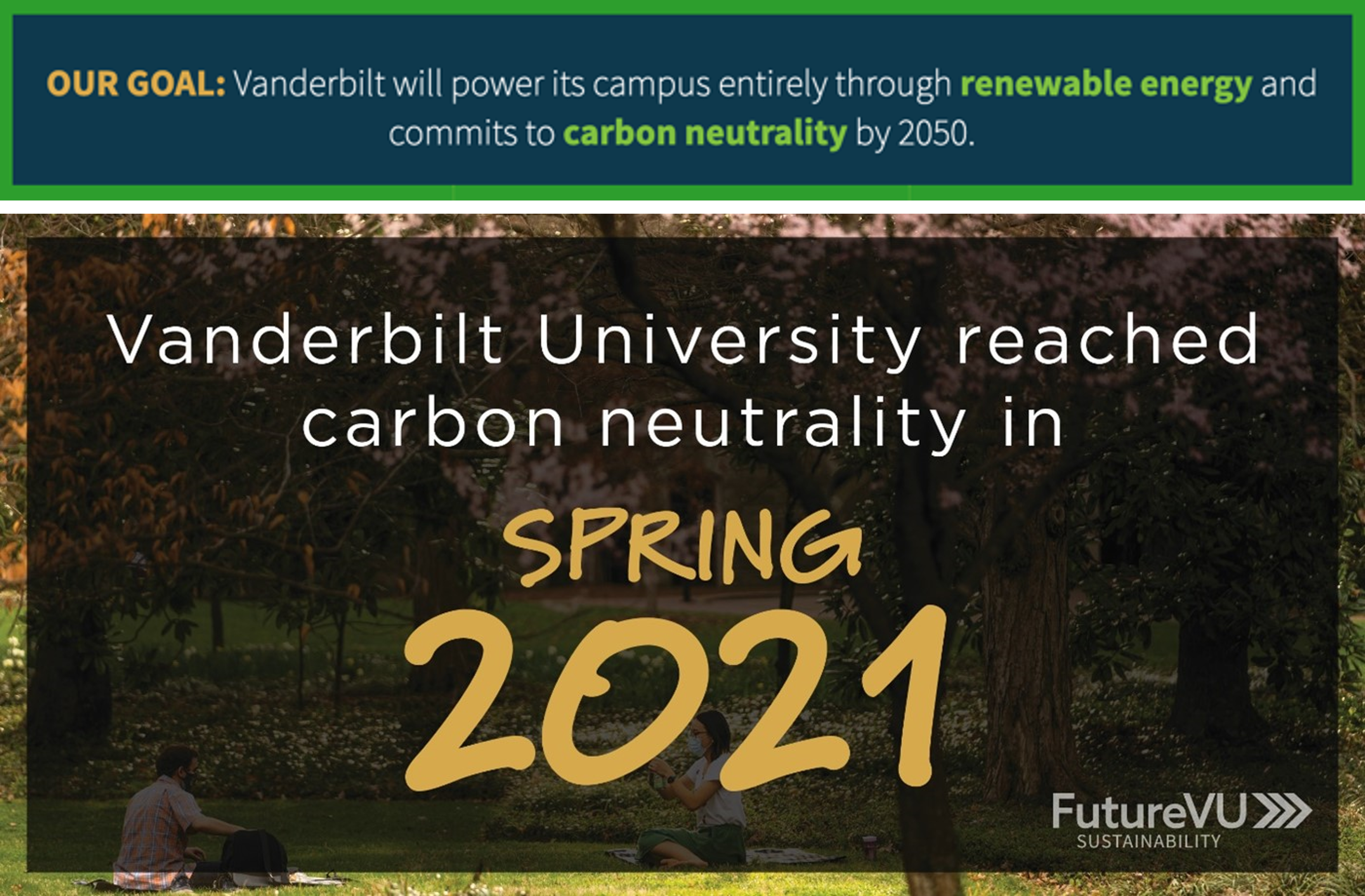
In 2021, Vanderbilt University reached carbon neutrality, decades ahead of its initial goal. A collaboration with the nonprofit organization Climate Vault allowed the university to address the full extent of its carbon footprint through offsets for FY19–20 and FY20–21.
In FY21–22, Vanderbilt University continued to offset its carbon footprint by investing in the development of solar energy projects that will expand access to clean energy in the Southeast with Clearloop, a Silicon Ranch company. Vanderbilt’s investment initially supports a solar farm in Panola County, Mississippi, in the town of Batesville—a community at the intersection of the Mississippi Delta and the Appalachian foothills. This solar farm will provide access to clean energy to approximately 1,000 Panola County homes. Vanderbilt will receive the carbon offset credits for the life of this solar project. Two more solar farms are planned as part of Vanderbilt’s collaboration with Clearloop.
Vanderbilt also opened its first solar farm through the Green Invest Program, the Vanderbilt I Solar Farm, in April of 2023.
Beginning in FY22–23, a portfolio approach will enable Vanderbilt to continue its carbon neutrality. In addition to offsets from Clearloop solar farms, Renewable Energy Certificates (RECs) from the Vanderbilt I Solar Farm in Bedford County will offset approximately 70 percent of the university’s annual indirect greenhouse gas emissions from electricity purchased through Nashville Electric Service, or the equivalent of enough power to help serve more than 6,000 homes for one year.
Vanderbilt’s total carbon footprint for FY22–23 is 113,823 MTCO2E. RECs from the Vanderbilt I Solar Farm offset 5,838 MTCO2E and carbon offsets from the Clearloop/Vanderbilt Panola County MS project apply to the remaining 107,985 MTCO2E, making Vanderbilt carbon neutral for FY22–23.
While the university continues to push action and innovations on several fronts to reduce emissions, the near-term opportunity to work with organizations like Clearloop allows Vanderbilt to accelerate its impact now.
More information about Clearloop and Vanderbilt I Solar Farm can be found later in the report.
GHG EMISSION SOURCES
Vanderbilt reports greenhouse gas (GHG) emissions across all major sources.
- Scope 1: The most significant source of Scope 1 emissions is natural gas use at the on-campus power plant and in individual buildings. Additional Scope 1 emissions include fleet vehicles, diesel use at the power plant, emergency generators, anesthetic gas use and refrigerant releases.
- Scope 2: Scope 2 emissions are entirely from electricity purchased from Nashville Electric Service.
- Scope 3: Scope 3 emissions at Vanderbilt include faculty, staff, postdoc and graduate/professional student commuting, air travel, waste disposal and recycling.
GHG EMISSION Summary
Vanderbilt University emitted 113,823 MTCO2E in FY22–23. These greenhouse gas emissions were split among Scopes 1, 2 and 3, at 55 percent, 32 percent and 13 percent, respectively. Scope 1 emissions are direct emissions from sources that are controlled by Vanderbilt, such as combustion of natural gas in the on-campus power plant. Scope 2 emissions are indirect emissions from purchased electricity. Scope 3 emissions are not directly controlled by Vanderbilt but are associated with Vanderbilt, such as faculty, staff, postdoc, graduate and professional student commuting, air travel, and waste and recycling disposal.
Compared with the FY21–22 greenhouse gas (GHG) emissions footprint calculation, the FY22–23 footprint shows an overall GHG decrease of 11 percent. Commuting emissions decreased significantly between FY22–23 and FY21–22 due to increases in telecommuting and greater insights into commuting behaviors through the MoveVU program.
VU’s GHG emissions per gross square foot have dropped by 34 percent over three years, despite a growth of 950,000 square feet over the same period. GHG emissions per person have also dropped 33 percent over the same time period.
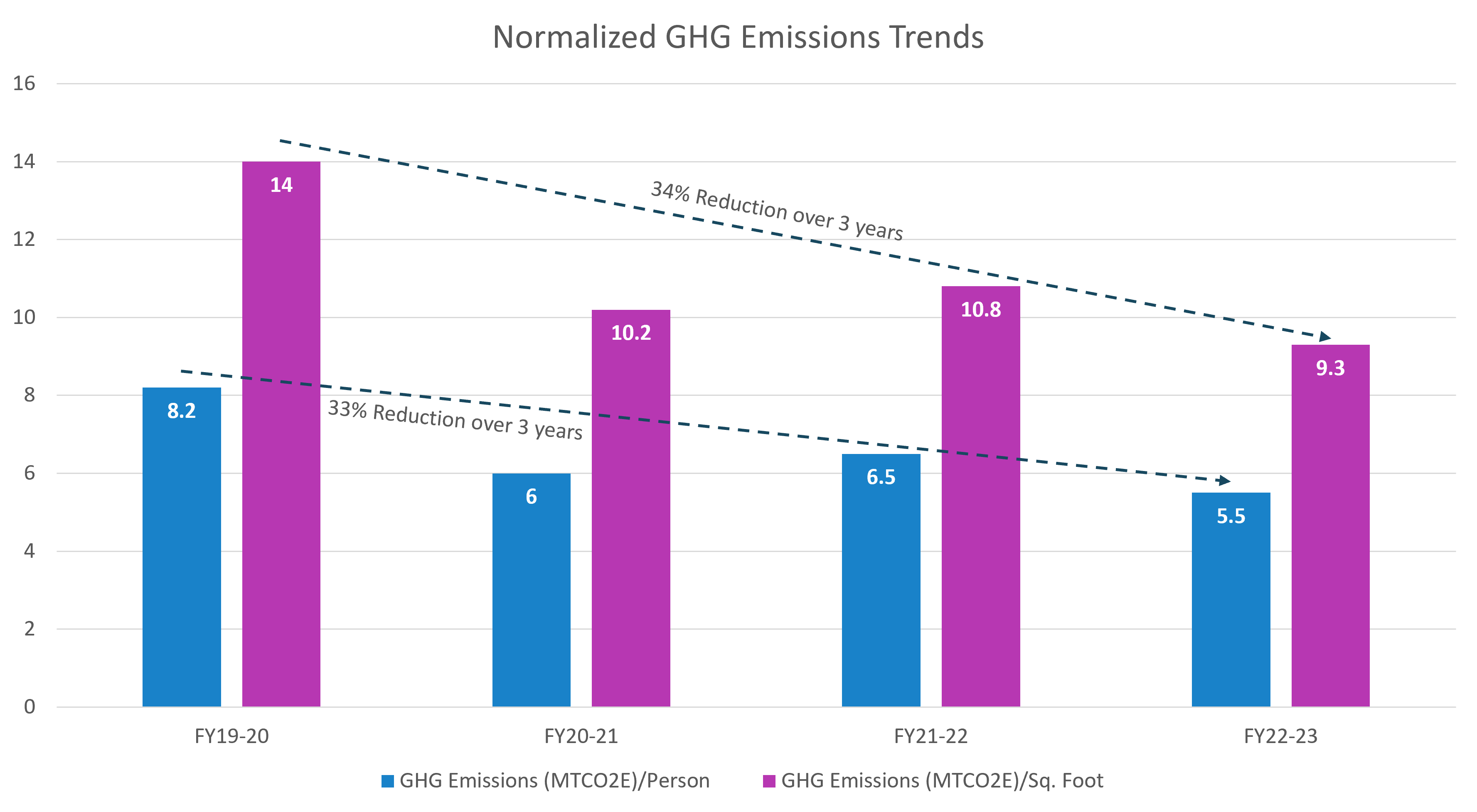
INVEST IN ON-SITE CLEAN ENERGY
on-site solar installations
There are solar-powered hot water heating systems at the Brownlee O. Currey Tennis Pavilion at the Lummis Family Tennis Center and at the David Williams II Recreation and Wellness Center; solar panels on the roofs collect the sun’s energy to heat the water for the buildings. Additionally, a 20kW solar panel system on the roof of the tennis center feeds energy into the Vanderbilt electricity grid. A dashboard of the solar panel system is online; access it with the login sustainvu@vanderbilt.edu and password: VU*Tennis.

INVEST IN OFF-SITE LARGE-SCALE RENEWABLE ENERGY
green invest program
After the BlueSky Energy Vision Study and the Large-Scale Renewable Energy Study in 2019, Vanderbilt entered into a pioneering agreement with the Tennessee Valley Authority and Nashville Electric Service to procure off-site large-scale renewable energy to mitigate the campus’ greenhouse gas emissions.
The first solar farm of the agreement, the 35-megawatt Vanderbilt I Solar Farm in Bedford County, opened on April 11, 2023.
This 350-acre solar facility is a significant step by Vanderbilt toward the ambitious goal it announced in 2019 to power its campus entirely through renewable energy and become carbon neutral by 2050. The renewable energy generated from the Vanderbilt I Solar Farm will offset approximately 70 percent of the university’s annual indirect greenhouse gas emissions from electricity purchased through Nashville Electric Service, or the equivalent of enough power to help serve more than 6,000 homes for one year. A planned second solar farm in Moore County, Tennessee, is projected to supply enough renewable energy to mitigate the remaining 30 percent of emissions.
The agreement is also providing hundreds of new jobs during the construction of the solar projects as well as unique educational and research opportunities for the Vanderbilt community, as both solar farms are in close proximity to the Nashville area.
Vanderbilt University’s Green Invest Program partnership with the Tennessee Valley Authority and Nashville Electric Service was recognized with a 2021 Governor’s Environmental Stewardship Award. The annual honors are considered the most prestigious environmental and conservation awards in Tennessee.
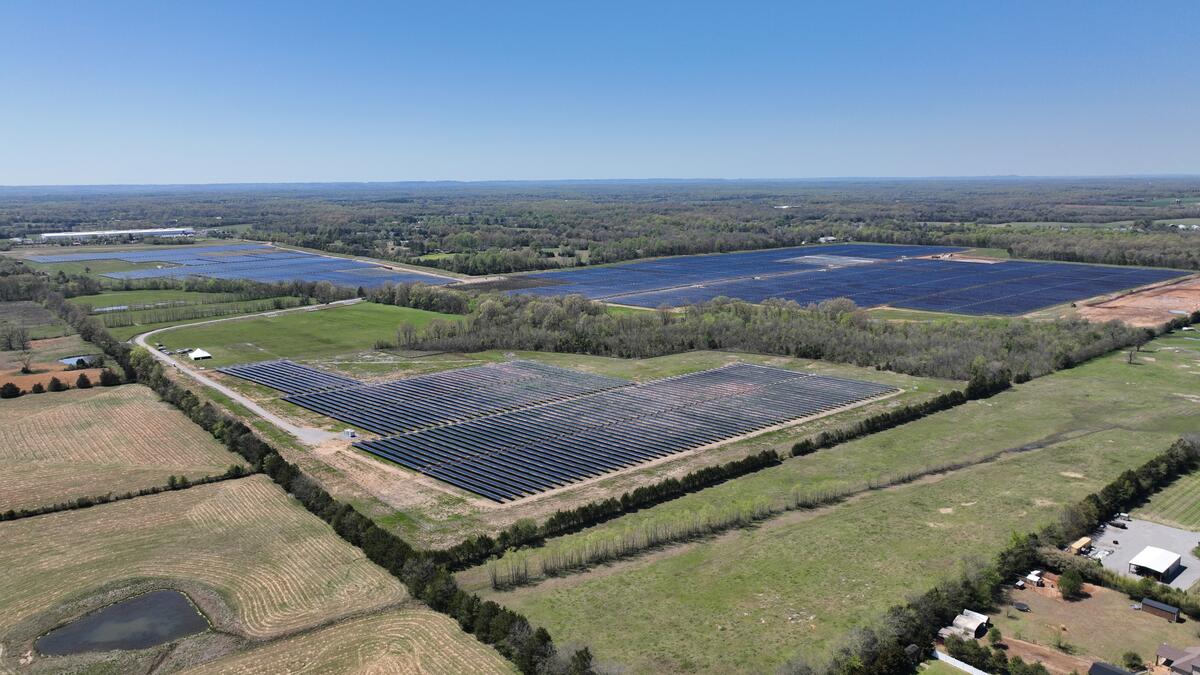
clearloop
Vanderbilt University is further offsetting its carbon footprint by investing in the development of solar energy projects to expand access to clean energy in the Southeast. A new, multiyear collaboration with Clearloop, a Silicon Ranch company, builds on Vanderbilt’s commitment to powering its campus entirely through renewable energy and maintaining carbon neutrality.
Vanderbilt’s investment initially supports a solar farm in Panola County, Mississippi, in the town of Batesville—a community at the intersection of the Mississippi Delta and the Appalachian foothills. This solar farm will provide access to clean energy to approximately 1,000 Panola County homes. Vanderbilt will receive the carbon offset credits for the life of this solar project, which offsets the university’s entire carbon footprint for FY21–22.
Two more solar farms are planned as part of Vanderbilt’s collaboration with Clearloop, which will contribute to offsetting this year’s carbon footprint as well as next year’s.
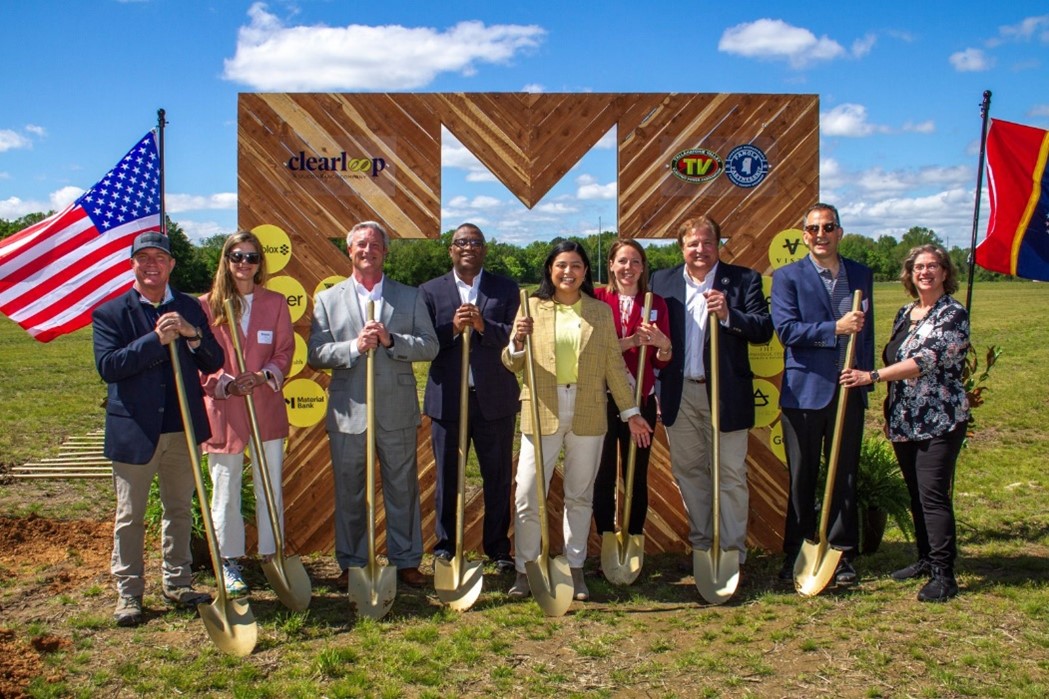
Decrease carbon footprint from vehicles
EMISSIONS SUMMARY
Vanderbilt is a major employer in Nashville. The university has more than 7,000 faculty and staff, is home to more than 7,000 undergraduate students and is the place of study for more than 6,500 graduate and professional students. Data about commuter behavior has significantly improved in recent years through MoveVU initiatives like the daily parking program and commute surveys.
The 2022 Commute Survey revealed commuting patterns that support an improvement in commuting emissions:
- 40 percent of respondents reported they worked entirely on campus, while 53 percent selected “hybrid” as their work status.
- The percentage of commuters driving alone to campus decreased from 79 percent of all commuters in 2019 to 52 percent in 2022.
- Approximately 12 percent of respondents say walking is their primary mode of travel to campus. This is an increase of 6 percentage points from the 2019 survey, when only 6 percent of respondents reported walking as their primary travel method. This increase was primarily driven by graduate/professional students and postdocs.
These additional insights into campus commuting, paired with shifting commuting patterns, have decreased emissions related to commuting by more than 60 percent between FY21–22 and FY22–23. Commuting emissions contributed 5,453 MTCO2E to the university’s carbon footprint in FY22–23.
Emissions related to air travel during FY22–23 remained relatively stable when compared with FY21–22. Transportation emissions are approximately 11 percent of Vanderbilt’s overall footprint.

MOVEVU
MoveVU is Vanderbilt’s strategic transportation and mobility plan that is part of the FutureVU comprehensive campus planning efforts. MoveVU goals align with FutureVU guiding principles to beautify the campus, preserve and enhance the park-like character people enjoy, create a walkable and sustainable campus, and better connect areas of campus that feel disconnected. MoveVU also outlines ways the university can shift its mode share goals, which aim to reduce the drive-alone rate to campus and encourage more sustainable commutes such as walking, biking, public transit and carpooling.
Vanderbilt is a leader in transportation initiatives and regional commuting needs and has seen success implementing programs and benefits for its community that promote sustainability. University programs and benefits from FY22–23 include:
-

Vanderbilt’s partnership with WeGo Transit allows the Vanderbilt community to ride for free, including Mr. C! Commute survey – an annual assessment of faculty, staff, postdocs, and graduate and professional students’ commute habits that tracks current mode share rates and informs future goals.
- Ride the bus free – Vanderbilt’s program provides all full-time and part-time Vanderbilt University students, faculty, staff and postdocs with free access to WeGo local buses, regional buses and the WeGo Star with their physical Commodore Card. This service is available for any place and time, not only when commuting to and from campus.
- Daily Parking program – participants pay only for days that they park on campus, which allows a daily choice in commute method and incentivizes the use of sustainable commutes.
- Sustainable commute incentives – eligible commuters can earn a $1 daily incentive each time they choose a sustainable commute over driving alone to campus.
- Guaranteed Ride Home – eligible commuters who take a sustainable commute to campus receive a free Lyft ride home in the event of an emergency or unforeseen circumstance.
- Commute Calculator – a personalized assessment of the best parking program to enroll in based on number of days on campus, salary band and sustainable commute choices.
- Commute Concierge – personalized consultations are available to the Vanderbilt community on using public transit, identify bicycle amenities on campus, Lyft Ridehail Partnership, sustainable commute routes and more.
The MoveVU program received the Tennessee Sustainable Transportation Award during the 2022 Tennessee Sustainable Transportation Forum and Expo, organized by the Tennessee Department of Environment and Conservation, the Tennessee Department of Transportation and Tennessee Clean Fuels.
FLEET ELECTRIFICATION
In 2023, Vanderbilt launched an all-electric multi-vehicle shuttle fleet for VandyRide, becoming the first university in Tennessee to do so. The transition to these electric vehicle (EV) shuttles are helping Vanderbilt further reduce its direct emissions. In addition to being environmentally friendly, the new shuttles are quieter and smoother than traditional buses, providing a more comfortable and healthier ride for passengers. The fleet consists of six 14-passenger ZEV4 electric shuttles, each with a range of up to 130 miles on a single charge.
INCREASE GREEN SPACES ACROSS CAMPUS
A guiding principle of FutureVU is that Vanderbilt resides in a unique and distinctive park-like setting. The plan looks to balance the distribution of open lawns throughout campus through careful evaluation of built and open space targets. The FutureVU framework calls for an overarching campus-wide target of 50 percent green space, 25 percent hardscape and 25 percent building footprint. As of the end of FY22–23, the campus breakdown is 37 percent green space, 33 percent hardscape and 30 percent building footprint.

To increase green spaces across campus, Vanderbilt has expanded the greenway network, the community garden, stormwater management practices and green roofs and has developed a landscape master plan as detailed below.
vanderbilt arboretum
When Bishop Holland McTyeire oversaw the planting of more than 1,000 trees on Vanderbilt’s campus nearly 150 years ago, he set in motion a time-release canopy that now provides widespread shade for the university community. Vanderbilt’s entire campus is designated as a Level II Arboretum and is home to over 6,500 trees and nearly 200 species of trees and shrubs.
As steward of today’s arboretum, an official tree replacement policy was developed this year to ensure that Vanderbilt’s tree canopy is preserved when possible and replaced whenever lost through construction.
In line with canopy goals outlined through FutureVU, the new policy will help campus partners think critically about designs that would avoid removal or damage to the root zone of significant trees. If trees must be removed or the root zone damaged, the policy provides guidelines for how to replenish the canopy.
Project managers working on new construction submit a worksheet to the university landscape architect at the beginning of the project that outlines its impact on the site’s trees before finalizing design and budget. If it is determined that a tree is negatively affected, the sheet will detail the species and diameter of the tree to be removed, as well as what may happen to the wood.
If a project cannot replant all the required trees within its boundary, the policy provides for the creation of a “tree bank” so that trees may be planted elsewhere on campus. These funds can also be used to support the campus landscape, improvements to infrastructure on the landscape or to sponsor planting and maintenance of trees in the wider Nashville community. This work will be summarized and reported back to the Arboretum Advisory Committee.
The university landscape architect will inspect all removed trees to decide if logs can be used for fabrication of furniture or other items. All new building projects, with oversight by steering committees, are encouraged to look for opportunities to reuse wood, either from the university’s stockpile or from trees removed during construction.
Outside of its capital projects, the university plants 30-40 trees each year independently to replenish losses due to environmental factors. The university landscape architect selects many of these by hand in partner nurseries in the Midsouth region.
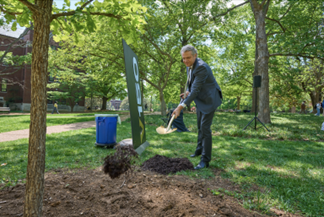
The Bicentennial Oak, which was Vanderbilt’s oldest specimen at around 250 years old, fell in 2022 due to age-related decay. Wood from the bur oak—which was five feet in diameter—has been salvaged. Because of the significance of this special tree, a committee has been formed to assess possibilities for how to use the wood.
The planting of a Sesquicentennial Oak took place in April, near the site where the Bicentennial Oak once stood. The new bur oak was the first part of a robust plan to plant more trees in honor of Vanderbilt’s 150th anniversary.
stormwater management/smart irrigation
Stormwater management practices are in place across campus. Nicholas S. Zeppos College collects and reuses rainwater from the roof to flush toilets. The Engineering Science Building has a cistern that collects stormwater from the roof for irrigation and includes a landscape with bioswales and a green roof to retain stormwater on site. Many additional sites across campus include stormwater pollution prevention measures, including vegetated drainage swales utilizing native plants, reduction in the amount of impervious area (replaced by landscaping) and pervious pavement, and use of a “smart” management system that allows for on-demand, efficient water use.
GREEN ROOFS
Vanderbilt has six green roofs across campus, which provide multiple benefits, including reduced energy use in buildings, reduced urban heat island effect, improved stormwater management, increased roof longevity and improved aesthetics.
Many of the green roofs at Vanderbilt are “hidden in plain sight” and act as plazas or lawns. The newest green roof was installed as a part of a major renovation of Eskind Library. A group of students organized a green roof awareness event in 2017 that led participants through the green roofs across campus to highlight these unique features and share information about the benefits.

Reduce consumption and waste
Zero Waste study and plan
The Zero Waste Study and Master Plan were developed in 2019 by the Zero Waste Advisory Committee to address the portion of Scope 3 emissions related to waste disposal and recycling and to progress toward Vanderbilt’s carbon neutrality goal. Of Vanderbilt’s Scope 3 emissions, waste and recycling is responsible for 2,551 MTCO2E, or 2 percent of the total GHGs that Vanderbilt emitted in FY22–23.
Based on past data, the committee recommended that the university should aim for the following two goals, along with two supporting actions:
GOAL 1: Zero waste (90 percent diversion from landfill) by 2030
GOAL 2: Reduce waste generated 30 percent by 2030
Supporting Actions:
- End institutional single-use plastic purchases by 2025, except in laboratories*; and
- Expand food waste collection to include all dining areas and residential halls by 2025
*Laboratories are exempt due to lack of available alternatives and safety concerns.
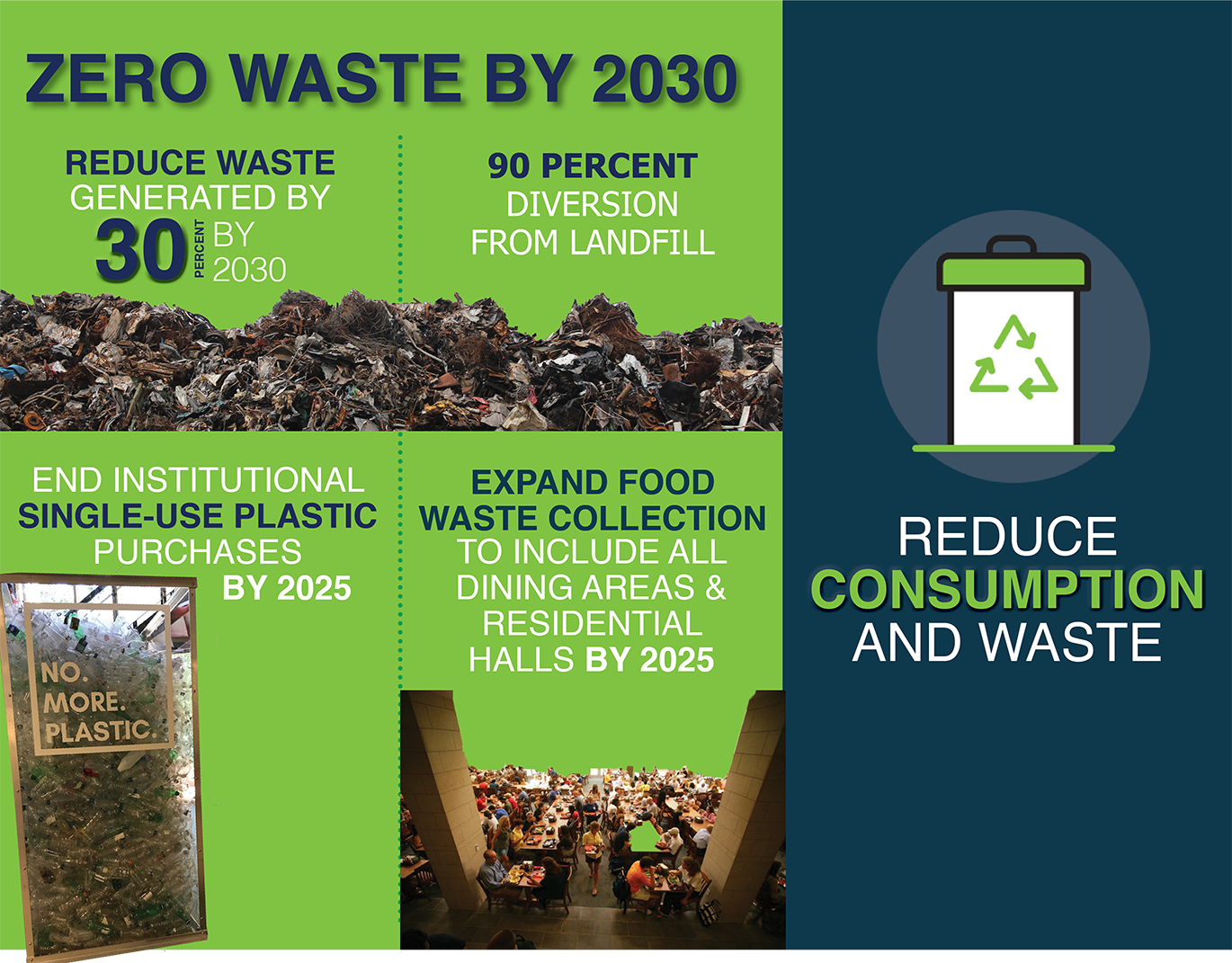
Campus Waste and Recycling
Vanderbilt has a 30-year history of recycling efforts to reduce waste going to landfills. In addition to traditional recycling programs for materials such as paper, plastic, cardboard and glass, Vanderbilt has recycling programs for nontraditional materials like construction and demolition debris, toner cartridges, batteries, light bulbs, scrap metal and electronics. Additionally, the ReUse program that started in 2016 sustainably manages unneeded furniture and equipment owned by Vanderbilt University departments and laboratories. Vanderbilt has also made significant efforts to reduce waste from its dining facilities in the form of food waste reduction and the reduction of waste from food service.
In FY22–23, Vanderbilt had a diversion rate for the university of 32 percent.
RECYCLING STREAMS
In FY22–23, Vanderbilt University generated 4,0152 tons of waste and 1,900 tons of recycling. Waste disposal accounts for 2,551 MTCO2E from Vanderbilt, or about 2 percent of our total emissions.
Vanderbilt’s 1,900 tons of recycling are broken down into specific streams below.
Single Use Plastic
In line with Vanderbilt’s Zero Waste and single-use plastic elimination goals, Vanderbilt University no longer sells single-use plastic water and soda bottles in its dining operations, including dining halls, markets and athletics concessions. The collaborative effort involved reduces plastic waste by more than 430,000 plastic bottles per year and over 1.7 million bottles during a graduating class’s four-year experience. All undergraduate students are given a free, reusable water bottle, and there are 134 hydration stations across campus. In further support of reducing single-use plastics on campus, Campus Dining has converted all disposable cups, containers, flatware, napkins and bags to compostable.
reusable container program
As part of Vanderbilt’s commitment to waste reduction, Vanderbilt Campus Dining launched a reusable container program in fall 2022 designed to significantly reduce the institution’s dependence on disposable to-go containers. Beginning in 2023, Campus Dining partnered with ReusePass to continue a reusable container program. ReusePass offers a straightforward process that empowers participants to effortlessly make eco-conscious dining choices and help curb single-use plastic waste.
ReusePass containers are available at the Commons Dining Center, E. Bronson Ingram Dining Hall, Rothschild Hall and Nicholas S. Zeppos Hall.
The reusable to-go containers replace the compostable to-go containers that were previously available in dining facilities, reducing waste created on campus.
Sustainable Food Practices
MINIMIZING FOOD WASTE
Campus Dining works on multiple fronts to reduce food waste. A software solution, known as Fusion, offers a complete food and nutrition solution from menu planning to production, food service operations, purchasing and cost management, and student mobile nutrition information. A second system called LeanPath tracks all pre- and post-consumer waste and records the information in a cloud-based system, allowing for department-wide analytics and waste analysis. Working together, these systems help avoid overbuying and food waste.
In the event that unused food remains, it is donated to local nonprofits to be redistributed to the Nashville community. Any food that cannot be donated is composted.
COMPOST
A program for composting food waste was started in October 2017 in the Common’s Center Dining Hall. The program currently includes pre-consumer collection for all dining prep locations, as well as post-consumer collection at all dining halls. Food waste is collected and composted by the Compost Company, a local vendor. In addition to food composting, all to-go food containers (outside of the reusable containers), cups, flatware and straws offered are made from compostable materials.
Vanderbilt reuses the compost created from our waste at the Compost Company to support our campus landscape, closing the loop on this waste stream.
Sustainable Dining
VU Campus Dining supports the well-being of diners and the health of our environment. Dining’s sustainability program is designed to give diners information about Vanderbilt’s kitchen principles and how they affect your environment, community and well-being. VU is also a member of the Menus of Change University Research Collaborative (MCURC). MCURC is a working group of leading scholars, food service business leaders and executive chefs from invited universities who are accelerating efforts to move Americans toward healthier, more sustainable, plant-forward diets.
Vanderbilt Campus Dining prioritizes increasing local purchasing to reduce our carbon footprint and support the local community. Inside the Commons Center, Rothschild College and Zeppos College, Campus Dining uses tower gardens to grow produce, including lettuce and herbs. This produce is used inside the dining halls for meals like sandwiches and pizza. Another local vendor providing produce to campus is HydroHouse Farms, founded by Vanderbilt alumnus Hassan Sharaff. HydroHouse Farms specializes in year-round hydroponic production of leafy greens and uses sustainable practices to reduce the amount of water needed for growing the produce by 90 percent compared with traditional farming techniques.
Additional local vendors include Bongo Java, Bobby John Henry Bakery, Kernels Nashville, Porter Road Butcher and Frothy Monkey. Creation Gardens, which prioritizes sourcing from local and regional farmers and shares Vanderbilt’s commitment to delivering the freshest and most nutritious ingredients, is a primary distributor for Vanderbilt Campus Dining. Creation Gardens provides an extensive range of local and regional produce, meats, seafood, pantry items and products that can be found throughout our dining halls.
Invest in sustainable infrastructure
ENERGY – EFFICIENCY PROJECTS
Greenhouse gas emissions normalized on a square foot basis have dropped more than 33 percent since FY19–20 due to a combination of ongoing energy efficiency improvements in existing buildings and green building techniques in new construction described further in the sections below.
LEED
Vanderbilt University was honored with a 2020 Leadership Award from the U.S. Green Building Council for the institution’s achievements in green building and its commitment to creating a healthy, sustainable future. The U.S. Green Building Council’s Leadership in Energy and Environmental Design rating system, known as LEED, has become the nationally accepted benchmark for the design, construction and operation of high-performance sustainable buildings. The council noted in its award announcement that Vanderbilt places a high priority on incorporating sustainability into the university’s construction and renovation projects.
Vanderbilt has a long history of building with sustainable and green features. The U.S. Green Building Council’s LEED Green Building Rating System is the nationally accepted benchmark for the design, construction and operation of high-performance sustainable buildings. This third-party certification is recognized as confirmation that a building is environmentally responsible. LEED projects earn points across nine categories: integrative process, location and transportation, sustainable sites, water efficiency, energy and atmosphere, materials and resources, indoor environmental quality, innovation and regional priority.
Vanderbilt University has a total of 25 LEED certified projects and was the first university in Tennessee to earn LEED certification.
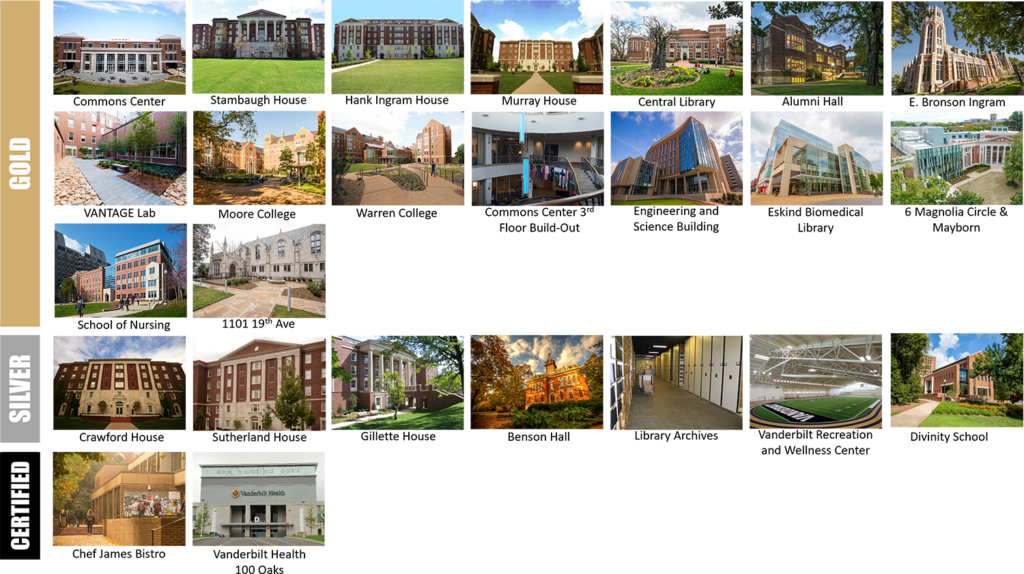
Well
Vanderbilt is exploring other certifications for sustainable buildings. The School of Nursing building expansion is Vanderbilt’s first WELL certification pilot, in addition to achieving LEED Gold. WELL certification serves as a credible label for a building’s effect on occupants’ health and well-being.

Living Building Challenge
Vanderbilt is also exploring the Living Building Challenge certification, which certifies buildings that are regenerative and positively impact the environment. Vanderbilt’s first petal certification pilot is the Peabody Home Economics and Mayborn Hall building complex, which is pursuing the Materials Petal. The intent of the Materials Petal is to help create a materials economy that is nontoxic, ecologically restorative, transparent and socially equitable.

WATER
Vanderbilt has taken significant steps to reduce its water use. Since 2007, Facilities has retrofitted 3,500 bathroom fixtures on campus to make them more water efficient and completes more each year. These efforts include low flow and no touch faucets, low flow and dual flush toilets, high efficiency showerheads and water free urinals.
ENGAGEMENT AND EDUCATION
FutureVU Sustainability acts as the sustainability information hub for Vanderbilt University. Together with the FutureVU Sustainability website, newsletter, social media and in-person engagement and education initiatives, FutureVU Sustainability has had the following engagement impact:

COMMUNITY ENGAGEMENT AND iNNOVATION
Vanderbilt hosted various opportunities for climate innovation and sustainability engagement over FY22–23.
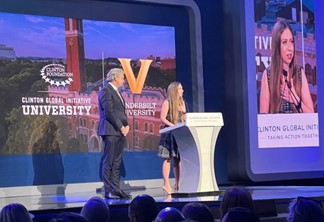
Nearly 700 higher education students representing 92 nations and 42 U.S. states gained expertise and inspiration from influential leaders during the Clinton Global Initiative University (CGI U) 2023 annual meeting, hosted by Vanderbilt University in March 2023. The CGI U annual meeting was led by former President Bill Clinton, former Secretary of State Hillary Rodham Clinton and Clinton Foundation Vice Chair Chelsea Clinton. Vanderbilt participants included Jonathan Gilligan, associate professor of earth and environmental sciences. The working session titled “The Race Towards Climate Justice” addressed the disproportionate impact of the climate crisis on people across the globe.
The Wond’ry, Vanderbilt’s Innovation Center, launched the Climate Innovation Accelerator program in 2023, adding to the depth of its climate-focused programming. The accelerator was co-created and led by Jaclyn Mothupi, director of social innovation at the Wond’ry. This 10-week program engaged minority-led/owned nonprofits and small businesses to identify innovative sustainability opportunities within their mission to equip entities to be more future-fit and climate-ready for those they serve. The inaugural cohort included five local small businesses and six nonprofits with a diverse set of missions, products and services to illustrate how innovation can work in different sectors to advance climate solutions, from reimagining packaging, services, stakeholder education, reporting frameworks and greening supply chains.
To help small businesses and nonprofits with limited resources prioritize sustainability and innovation, the accelerator provided in-depth sessions on the topics and strategic frameworks to bring both to life.
Green Fund
The Vanderbilt Green Fund (VGF) provides funding to student-initiated projects that reduce the greenhouse gas emissions or improve the overall sustainability of the Vanderbilt University campus. VGF enables students, faculty and administration to directly engage in the process of transitioning to a clean and sustainable future. Any student, faculty or group associated with Vanderbilt University can propose a project for consideration.

Facilities and the Vanderbilt Environmental Health, Safety, and Sustainability office annually provide $150,000 to the VGF. Green Fund proposals are first evaluated by a student committee that is organized jointly by Vanderbilt Student Government (VSG) and Students Promoting Environmental Awareness and Responsibility (SPEAR). Top proposals are recommended by the student committee to the Green Fund Working Group — comprised of faculty, administrators and students — which makes the final funding decisions.
PAST REPORTS
Vanderbilt is committed to the highest standards of transparency and sustainability through a process of environmental responsibility and accountability at every level of the university. With regard to climate change, this commitment translates to actions aimed at reducing GHG emissions at the university, departmental and individual level.
The publication of a university-wide GHG emissions inventory has occurred annually since 2005. These reports provide key data points, past trends and successes of Vanderbilt University and its efforts to curb greenhouse gas emissions and operations.
The listing to the right provides downloadable files of our past greenhouse gas inventories and reports.
From 2008 to 2015, Vanderbilt University, including Vanderbilt University Medical Center, reduced its overall greenhouse gas emissions by 27 percent. In 2016, the university separated from the medical center, resulting in changes to its boundaries, operations and size of population, which necessitated a new 2016 baseline.
- FY 2021-2022 Annual Sustainability Report
- FY 2020-2021 Annual Sustainability Report
- FY 2019-2020 Annual Sustainability Report
- FY 2018-2019 Annual Sustainability Report
- FY 2017-2018 Annual Sustainability Report
- 2016 Annual Sustainability Report
- 2015 Greenhouse Gas Emissions Inventory Update,
Published October 2016 - 2014 Greenhouse Gas Emissions Inventory Update,
Published October 2015 - 2013 Greenhouse Gas Emissions Inventory Update,
Published October 2014 - 2012 Greenhouse Gas Emissions Inventory Update,
Published October 2013 - 2011 Greenhouse Gas Emissions Inventory Update,
Published October 2012 - 2010 Greenhouse Gas Emissions Inventory Update,
Published October 2011 - 2005-2009 Greenhouse Gas Emissions Inventory Update,
Published October 2010 - 2005-2007 Original Greenhouse Gas Emissions Inventory
Contact
Andrea George, PhD, BCES, CHMM, PMP
Assistant Vice Chancellor, Environmental Health, Safety, and Sustainability
Email: andrea.george@vanderbilt.edu
Steve Gild, MS, CHMM
Environmental Compliance Program Manager
Email: steve.gild@vanderbilt.edu
Chelsea Hamilton, MS, LEED AP
Sustainability Program Manager
Email: chelsea.l.hamilton@vanderbilt.edu
For questions or further information, email futurevusustainability@vanderbilt.edu

